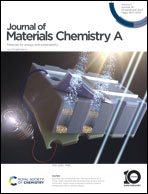Biomimetic polyelectrolyte-gradient hydrogel electricity generator: a green and portable energy source†
Abstract
Research on portable and eco-friendly electricity generators is promising for sustainability, as it helps address environmental pollution, depletion of fossil fuels, and the widespread use of personalized electronics. Inspired by the asymmetric charged structure of blood cells, we developed a bi-layered polyelectrolyte-gradient hydrogel electric generator (PGHEG). The polyelectrolyte concentration difference between the bi-layered hydrogels induces a spontaneous ionic directional diffusion, thereby realizing the transport of electrons and the electric signal generated in the external circuit. The output voltage of the PGHEG can be easily adjusted by varying the polyelectrolyte concentration using anionic lignosulfonate sodium (LS) or cationic quaternary chitosan (QC). In particular, the LS-assembled PGHEG can generate a maximum output voltage of ∼130 mV at room temperature. Further, the output voltage of the device with the integrated structure can be as high as ∼1300 mV, which is sufficient to power a small electronic device like a calculator. The PGHEG-based device is simple, low-cost, flexible, and portable, as well as biodegradable upon disposal, all of which are critical aspects for developing green wearable devices.



 Please wait while we load your content...
Please wait while we load your content...